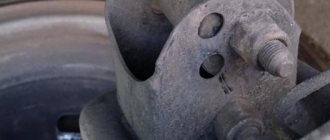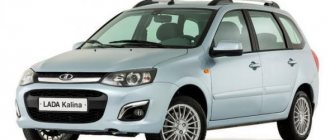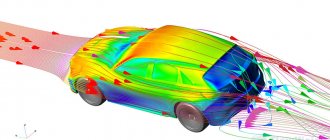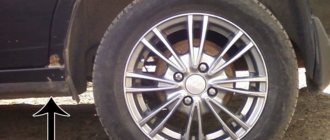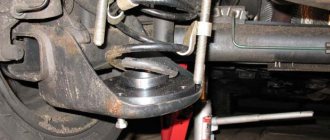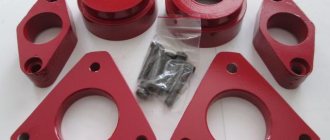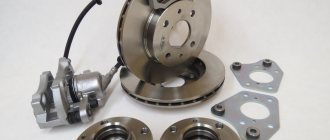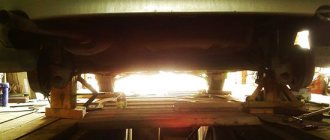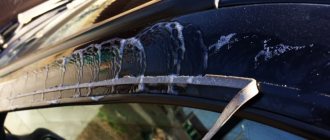The answer to the question “what is a car’s ground clearance?” simple - the minimum height of the middle part of the car from the surface. That is, the distance between the bottom and the road.
Actually, not just a car. Any vehicle. There are special tractors with a ground clearance of two meters. And the tank’s high ground clearance makes it more visible and vulnerable in battle. Although cross-country ability is a very important quality for him.
Advantages of cars with low clearance:
- excellent road holding. A low center of mass helps with cornering stability. All racing cars are like that;
- efficiency. All other things being equal, the drag is slightly lower, which saves fuel;
- "fuzzyness". The sporty, fast-looking silhouette of the car warms the soul of the owner.
The advantage of cars with high ground clearance. One thing, but a very significant one. Patency. Such a car will not sit on its bottom in bad conditions. It will travel in the direction that roads still exist in our place. Easy parking - it won’t catch a curb or a stone in a snowdrift.
It is significant that high ground clearance raises the center of mass of the car, making it prone to tipping over on sharp turns. Therefore, when driving on good roads at high speeds, it is worth reducing it.
Based on clearance height, cars are conventionally divided into:
- passenger cars –110-180 mm. We take into account that the average height of the curb is 16 cm;
- crossovers, SUVs - 160-220 mm;
- SUVs – 200-420 mm.
Alas, it's not that simple. There is also such a thing as “body geometry”. A long car with a high body can give up even before entering a tow truck. And the Peugeot 107 easily climbs up or down a hill, goes around the pits along the contour, without touching anything.
The VAZ-2131, having lengthened by half a meter from the classic Niva, acquired the harmful ability to regularly cling to something.
VAZ-2131
More. The bottom is not a solid plate. It’s worth inspecting your car on an overpass; knowing where and how much the parts protrude, you can carefully “skip” a post or stone under the bottom.
For family cars with high ground clearance, we can recommend the Volkswagen Polo Sedan 1.6 with a height of 170 mm.
Volkswagen Polo Sedan 1.6
Relatively inexpensive, roomy, passable. When choosing a family car, you should look beyond ground clearance, even if the choice is based on operating conditions. We take into account price, efficiency, trunk size, cost and availability of maintenance.
When looking for a model of an economical car with high ground clearance, you should take into account the contradictory requirements: low cars are more economical. So we are looking for a reasonable compromise in the requirements. You can pay attention to the “C3 Picasso Trekker” with a clearance height of 175 mm or Nissan Juke – 180 mm. All-wheel drive, automatic transmission, high engine power on average increases fuel consumption.
Nissan Juke
Among inexpensive, budget cars with high ground clearance, the Russian Lada 4×4 and Chevrolet Niva are interesting. Similar to each other - mechanics, all-wheel drive, 1.7 liter engine with 80 horses - cars with excellent cross-country ability.
Chevrolet Niva
The Chinese are doing quite well in the budget class, making quite decent cars at a relatively low cost.
Ways to increase ground clearance
How to increase car clearance. There are cars with active suspension. Their design includes the ability to change the height of the car literally “on the fly”, raising or lowering depending on driving conditions.
Hydraulic, pneumatic and hydropneumatic systems are controlled by an on-board computer. Provision is made for raising and lowering each wheel depending on the conditions: at different cornering speeds, uneven roads, at the start, braking. Installed sensors assist the movement without driver intervention.
Adjustable Air Suspension (ESS)
Cars equipped with such systems move smoothly, driving is more comfortable and safer. Alas, you have to pay for everything. Both in the literal sense: such models are more expensive, and in the figurative sense - the complication of the design leads to more complicated maintenance and reduced reliability.
A simple way to increase the car's ground clearance is to install different wheels.
It has nuances. Wheels 195/65R15, 205/55R16, 225/45R17, 225/40R18 have almost the same external size. It is necessary to take into account the change in the rubber profile, choose the same profile, but with an increased radius.
There are also failures caused by geometry. With the same number of wheel revolutions, the distance the car travels is different. That is, irregularities in the speedometer readings are possible. The speed sensor is likely to fail in vehicles equipped with ABS and ESP systems, if any. And it won’t be possible to increase it much - the wheel arches will interfere, possibly touching the mudguards.
We recommend: How to choose a used car
Another option is to replace the springs and shock absorbers, and supply additional “gaskets”. Many workshops now provide such services. We take into account that the replacement of standard components of the car automatically leads to the loss of the factory warranty, if it has not yet expired. Such replacements also affect the stiffness of the suspension.
It is also worth considering one not very good, often encountered and rarely taken into account minus. Any repair or tuning of a car is fraught with encounters with cross-eyed repairmen. Moreover, outwardly you cannot distinguish them from conscientious workers. Such a meeting easily leads to loss of money, nerves, and time. Theoretically - and life, well, this is in very rare cases.
A car “raised” by tuning, in comparison with the purchased base model, can noticeably lose stability. When entering a corner at speed, the difference is noticeable.
Video: installing spacers to increase the ground clearance of the Kia Ceed Sportage 3.
Video: increasing the ground clearance of the Mazda3 due to spacers, shows what happened and how it turned out.
All SUVs are vehicles with high ground clearance. For ease of selection, familiarization and comparison of different models and brands of cars, look at the numbers below.
Tables for comparing clearances
When buying a car, you can decide in advance on the ground clearance. The two tabular forms below will help you with this. See and choose your size.
Car clearance - comparison table. This form shows the difference between cars and SUVs:
Below is a table of the most purchased class B cars; ground clearance increases from bottom to top. Compare the ground clearance of different models and manufacturers, and choose the best option:
The stated ride height does not always correspond to reality. For example, it is clear that a loaded car will “sink” lower than an empty one. According to Russian GOST, measurements are taken in a vehicle loaded to the maximum permitted weight.
And at the Russian representative office of Mitsubishi, when asked by Avtovestya, they answered that the measurements are carried out on a loaded car. That is: there is no driver and passengers, the fuel tank and windshield washer reservoir are filled, there is a spare wheel and a set of tools, a jack. Just a car standing on a stand.
The underbody protection installed in the car “eats” a few more millimeters. Again, the clearance is indicated with the protection removed.
Underbody protection
Additional protection for the bottom of the car is possible. The options are different. There is simply anti-corrosion protection, usually coating with various mastics, paints and the like.
This is not a superfluous thing, since when driving, grains of sand and fine gravel treat the bottom of the car like an abrasive. Using salt on the roads in winter also does not add longevity to the body.
But you can also order more expensive protection that protects the engine crankcase (one of the most expensive repairs), gas tank and other parts from impacts. Theoretically, at least from mine fragments, like on armored personnel carriers. The installation of additional protection itself will slightly reduce the ground clearance, but will save you from significant expenses for repairs.
Video: does the crankcase protect the car?
Plastic skirts and various parking systems, such as sensors under the bumper, help. Without increasing the vehicle's ground clearance, they protect against damage by signal transmission.
Ground clearance changes slightly over time due to wear and tear on suspension parts - springs, springs, tires. Even with different vehicle loads and tire pressures, it is slightly different. When driving around curbs, parking, or obstacles, not only ground clearance is important. You also need a careful driver.
WHAT IS CLEARANCE AND OVERLOADS IN A CAR. FEATURES, TYPES AND HOW TO MEASURE
Good afternoon, today we will learn what is called clearance
or
ground clearance
,
why
is so
important to know
this
indicator
and
how to correctly measure the distance
from the ground to the lowest point
the vehicle
’s underbody yourself
.
In addition, we will tell you what the
angles of the front
and
rear overhangs
in a car
are why
these
parameters
and
how to accurately
determine
them .
In conclusion, we’ll talk about what types of ground clearances there are
for vehicles,
how to choose
a car with
the optimal level
, as well as
what advantages
and
disadvantages
cars with
high ground clearance
.
As you can see, today there are a large number
various and at first glance
incomprehensible
automotive
concepts
, using the example
of ground clearance
or
overhang angles of
the vehicle body.
Quite often, car enthusiasts
have a pressing
question
:
what is ground clearance
,
how does it differ
from
ground clearance
and
how
to measure
it in your car?
We’ll answer right away that ground clearance
and
ground clearance
are
the same parameters
, only they have
different names
.
Such a “ fashionable
”
concept
as
clearance
came to us from
the Western lexicon
and
has taken root quite firmly
among our people.
For reference, we note that the values of ground clearance
and
overhang angles
are one of the key
indicators
in terms of
measuring the height distance
from
the bottom point of the car body
to
surface
.
We recommend: 15 best brake pad manufacturers
Why is clearance needed and what does it affect?
Clearance is explained by GOST as the distance between such parts of the car as the supporting surface and the lowest point of the central part of the entire structure. Simply put, this is the distance that separates the prospect of damaging the lowest part of the car and the road surface. More often, this concept can be heard in such a form as ground clearance - it is more understandable, easier to remember and therefore used with great pleasure.
The amount of ground clearance is a very important characteristic for any car, as it significantly affects stability at high speed, cross-country ability, and maneuverability. And these, without a doubt, are the indicators that can demonstrate the car in the best light. As for cross-country ability, it can be increased along with an increase in value. By the way, this can be done while driving – on some cars.
As a rule, ground clearance is indicated in millimeters, sometimes also in centimeters. It is also common practice to notify car owners about two values - clearance under the front and rear axles. Sometimes they even indicate the clearance that is under the engine crankcase.
To make it easier to characterize clearance, in the future, using a table, a conditional classification of this characteristic should be given. In general, ground clearance can be divided into three categories: high (SUVs and SUVs), medium (crossovers and SUVs), small (passenger cars). And now regarding the specific values of ground clearance under the front bumper:
- 20-35 cm for SUVs.
- Not less than 18 cm and not more than 25 cm for SUVs.
- 14-20 cm for cars.
As for the oil pan, these are the following values:
- From 20 cm for SUVs;
- From 17 to 21 cm for SUVs;
- From 12 to 17 cm for passenger cars.
Seven passenger cars that will compete with crossovers off-road
We love crossovers for their ability to comfortably transport us over rough roads and light off-road conditions. However, as it turned out, ordinary passenger cars also have quite good off-road capabilities. In our review, we will rely solely on geometric cross-country ability, that is, the ability to overcome roads with deep holes, slopes and descents. To do this, we take into account ground clearance, as well as front and rear overhangs.
Some terminology
To avoid confusion in terms, we took state standards. So.
Ground clearance is the distance between the supporting surface and the lowest point of the central part of the car (GOST-R 50182 “Road transport. Dimensions for passenger cars”). Most often this low point is the engine oil pan. Actually, the greater the clearance, the better for cross-country ability.
Passenger cars - competitors of crossovers
High ground clearance and short overhangs are the province of inexpensive cars for developing countries, and there are a number of reasons for this.
- It's not beautiful. A middle or business class car with high clearance will look awkward.
- This is uneconomical and unsporting. The greater the clearance, the worse the aerodynamic characteristics of the car, which means slower acceleration and higher fuel consumption.
- We need to attract buyers to crossovers. If passenger cars can drive freely on broken roads, why will “city” crossovers be needed?
Thus, if you are looking for a car with good cross-country ability and a high level of comfort, then you will not find a passenger car with the makings of a crossover in this segment.
Comparison table
We have collected the technical characteristics of cars with good cross-country ability compared to their classmates in a summary table. Please note that each model has both strengths and weaknesses.
For example, Logan and Sandero have short overhangs but modest ground clearance. The Peugeot 408 has the opposite: impressive space under the bottom and indecently long overhangs that tend to catch the ground during ascents and descents.
There is no clear leader among cross-cars, although the Renault Sandero . However, for those looking for a car for light off-road use, we recommend purchasing it in the Stepway version, which has a ground clearance of 175 mm (20 mm more) and the same beautifully short overhangs.
The characteristics of the Lada Kalina 2 look comparable to the “regular” Sandero. After the 2012 update, its front overhang has increased, but the rear overhang is still short. There is a small gain in ground clearance.
| Ground clearance | Front overhang | Rear overhang | |
| Renault Logan | 155 | 800 | 858 |
| Renault Sandero | 155 | 785 | 625 |
| Lada Granta | 165 | 804 | 980 |
| Lada Kalina | 160 | 800 | 640 |
| Peugeot 408 | 175 | 939 | 1041 |
| Skoda Fabia | 150 | 860 | 675 |
| Citroen C-Elysee | 142 | 808 | 967 |
| Volkswagen Polo Sedan | 170 | 850 | 982 |
But what about real crossovers?
Quite a lot of cars are sold on the Russian market, which marketers classify as crossovers, but at the same time their geometric cross-country ability leaves much to be desired. For example, we can recall the Honda CR-V, Kia Sportage, the new Chery Tiggo 5, Peugeot 2008 and Kia Soul. We will make a detailed analysis of the off-road capabilities of these and similar vehicles in a separate publication.
We evaluate the scope of operation - personal clearance requirements
Each potential car buyer has his own requirements for what the car should be like. Almost everyone has individual wishes for a car, which is why there are so many offers in the modern world. In most cases, the buyer will give preference to such parameters as engine power and maximum speed, a good type of gearbox and acceleration of up to 100 kilometers per hour. But an experienced driver will definitely look at the ground clearance. For an experienced driver, this element of technical characteristics sometimes means more dynamic performance, since it determines the ability to operate the car in certain conditions. Among the main requirements are the following features:
- for urban use, the ground clearance should not be less than 120 millimeters; for a confident ride in winter, 140 millimeters may be required;
- when traveling on intercity highways, when the car is fairly pressed to the road at speed, a slightly higher ground clearance is required - from 140 to 160 millimeters;
- the minimum ground clearance on a car that is used in rural areas is 180 millimeters, here the question turns out to be simple - the higher the ground clearance, the better;
- for off-road travel, it is better to have a ground clearance of more than 200 millimeters; an extremely pleasant option will be the ability to adjust the clearance using suspension settings;
- for universal use, the optimal ground clearance is considered to be a ground clearance of 150-180 millimeters; this option is suitable for all travel features.
Modern cars often have more ground clearance, especially cars in the SUV class. However, it is not always the clearance that determines the passability. We know many Chinese cars in the SUV class that cannot drive on a normal asphalt road, despite their fairly high ground clearance.
Therefore, ground clearance is more of an additional factor than a determining factor. However, if there is a lack of this clearance, you can suffer greatly, receiving not the most pleasant features of the car’s operation and constantly spending money on regular restoration of the vehicle after damage.
What are the consequences of low vehicle clearance in unsuitable conditions?
If you look at cars in Germany, most of them have a ground clearance between 120 and 140 millimeters. Even crossovers for the local market are made with low ground clearance. The fact is that the roads here in winter and summer meet the highest quality requirements. In our country, everything is somewhat different. If in the summer you can drive along the roads you know in the city with any clearance, then in the winter or along an unfamiliar road you will have to crawl, because you do not know what awaits you in a couple of hundred meters. Low ground clearance will create the following serious troubles for the car owner:
- damage to elements of the lower part of the car when hitting a bump on the road, which visually passes between the wheels of the car;
- problems at speed, when the car is pressed to the track by aerodynamics, and irregularities create large amplitudes of vibration of the stern - you will constantly scratch the road with your rear mudguards and can damage the bumper;
- traveling along a rut on a country road will only cause negative emotions; you will have to move along the “crest of a wave,” which in some cases is not easy, and sometimes simply impossible;
- you will regularly put the car on its belly in the winter, every time you drive into a yard with a knurled rut and ice gouges, you will have to push the car out;
- there will be a need for frequent repairs of various problems, including breakdowns of the chassis, blown boots and sensors of various mechanisms.
As you can see, poor-quality operation of the car is quite possible with just one incorrectly selected parameter. If the ground clearance of your car does not suit you, you can deal with this problem in two ways. The first is purchasing another car with more pronounced ground clearance. The second is the placement of special boosters under the struts, which will provide an additional centimeter of ground clearance. Of course, the latter option often negatively affects the appearance of the car, provided there are no other changes. Many drivers argue that you just need to get used to certain parameters of your car’s ground clearance and know the car’s capabilities. We offer a short video about the effect of a car’s ground clearance on its operation:
We recommend: Rules for towing a car
The best all-wheel drive minivan with high ground clearance
If we talk about minivans with high ground clearance, it is quite difficult to find a new car - most likely, you need to look on the secondary market. Despite this, there is quite a lot of interest in such vehicles, so some very good models can be found.
Citroen C8
One of the best options for regular travel. The ground clearance of the model reaches 19 cm, so you can drive it anywhere. Many also speak highly of the Citroen C8 due to its elegant exterior.
The inside of the cabin is quite spacious; if desired, you can conveniently adjust and move the seats back. The car also performs well on the move, while delighting with excellent handling. In principle, there is nothing more you could want from a car of this class.
Toyota Sienna
In our country, such a car is quite expensive, so there is not that much interest in the model. At the same time, if we talk about the characteristics of the vehicle, they are quite good. There is a wide range of power units to choose from, all of which demonstrate high reliability and quality.
There are both all-wheel drive and front-wheel drive models. The engines are paired with only an automatic gearbox, which many consider as a minus, but there are no complaints about the controls.
Renault Espace
The model's ground clearance reaches 12 cm. This large and comfortable car copes well with off-road conditions. It is also worth highlighting the spacious and comfortable interior, as well as the presence of a 1.9 liter diesel engine, which shows good power and dynamism.
For many, this car is associated with a cruising yacht, and this is not in vain, because both the appearance and the level of comfort are simply excellent.
Option "bad road package"
When choosing a car, many buyers pay attention to its ground clearance, and this is natural, because the vehicle’s cross-country ability depends on the ground clearance, and this is an important advantage in our operating conditions.
As a rule, jeeps, crossovers, and SUVs have high ground clearance.
But many manufacturers, meeting the buyer who does not want to buy an expensive car, but at the same time dreams of becoming the owner of a car with high ground clearance, are introducing a special “package for bad roads” option for sedans and hatchbacks.
As a rule, this package provides:
- This model has increased ground clearance compared to its European counterpart, usually 3-5 cm;
- Reinforced chassis (levers – thickened polyhedral steel, reinforced springs, shock absorbers);
- Adaptation of the engine to our operating conditions (to our fuel);
- Factory installed engine protection;
- Other options depending on vehicle model.
But you need to take into account that the automaker indicates the ground clearance measured on an empty car; with passengers and cargo in the trunk, the ground clearance will decrease by a couple of centimeters, so many car owners, after purchasing a car, immediately try to increase this parameter using spacers, but this is another topic for discussion. And now about the main thing.
Small cars with high ground clearance
There is a stereotype that high ground clearance is a characteristic only of powerful SUVs. However, not only SUVs can boast of this indicator. There are several small cars that nevertheless have significant ground clearance:
- Renault Logan (engine capacity 1.6 l) - 175 mm;
- Ford Focus 2 (engine capacity 1.4 and 1.8 l) - 110–150 mm;
- BMW E 90 - 142 mm;
- VAZ cars - 160 mm.
Good ground clearance means that you can safely drive on roads with holes and potholes, without worrying about the integrity of the muffler and various elements located on the bottom of the car at its lowest points. Each car from the above has unsurpassed charm, pleasant design, individuality and high technology. And if you do not want to experience inconvenience due to low ground clearance, then you should choose one of the named representatives, who will delight you for many years when traveling around the city and in nature.
Table of distances of some popular cars
| Make and model | Ground clearance, mm |
| Mitsubishi Outlander (since 2013) | 215 |
| Nissan X‑trail (since 2015) | 210 |
| Toyota Rav 4 (since 2012) | 197 |
| Suziki Grand Vitara (2005–2015) | 195 |
| VW Jetta (since 2011) | 170 |
| Mitsubishi Lancer X | 165 |
| Hyundai Solaris | 160 |
| Ford Focus 2 | 140 |
